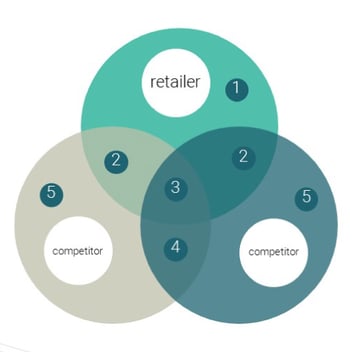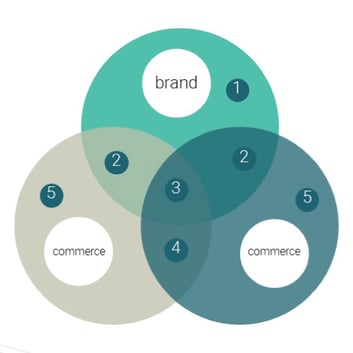Analysing internal data should be a part of daily business in most companies. Once companies have gained a good overview of turnover, sales figures, product range and customers, it is also important not to lose sight of the market. If a company only looks within, it is blind on one eye. The consequences are wrong decisions, which ultimately have an impact on the turnover. Only by linking them with external market data the company's KPIs can unfold their full potential.
To show how companies can benefit from this external data, two possible scenarios are examined in more detail below.
Scenario 1: Optimising the retail product range
Retailers have a constant interest in optimising their own assortment. The question of which products to include in their portfolio and which to drop cannot be answered simply by looking at internal data. Only by comparing one's own assortment with that of competitors potentials can be recognised and well-founded decisions can be made for one's own assortment development. In this case, the market data serve as a kind of interpretation aid, as a benchmark to put one's own data into perspective.
The first step is to identify a company's competitors. This is done by analysing which retailers have a similar product world. The next step is to identify overlaps in the assortments of the company and those of its competitors. Five different product categories are differentiated:
 1. Exclusive in own assortment: these products are either important unique selling propositions that differentiate a retailer and set it apart from the competition or low-performers that the competition does not have in the shop for a good reason.
1. Exclusive in own assortment: these products are either important unique selling propositions that differentiate a retailer and set it apart from the competition or low-performers that the competition does not have in the shop for a good reason.
2. Intersection with other competitors: further potential can be identified here.
3. Must-have assortment: customers expect these products, so it would be fatal to remove them from the assortment.
4. Intersection of competitors: retailers should question why they do not have these products in their range. There is potential here for their assortment.
5. Exclusive products of individual competitors: it is also possible to identify potential here.
An analysis of the external assortments (4 and 5) can provide valuable insights and suggestions for the development of one's own assortment. For example, if an increase in products with the attribute "vegan" is observed across all shops, a trend towards more vegan products can be derived from this. The own assortment can be adapted accordingly. For example, in the fashion industry, the trend could be towards a certain colour or pattern.
Scenario 2: Sales channels for brands
Brand producers can also gain valuable insights from external market data. Especially due to the temporary closure of many retail shops in the course of the Corona crisis, the relevance of online distribution channels has grown massively. For manufacturers, this has increased the need for transparency for these sales channels. However, they often lack an overview of which retailers sell their products online at which prices on which channels. Market monitoring can provide them with this information. In addition, by monitoring the market, they can also find out about the general price development of their products, observe sales and sell-offs, and recognize top sellers.
The sales channel analysis identifies five different product categories:
 1. Direct sales products: these products are sold by the brand itself through its own shop.
1. Direct sales products: these products are sold by the brand itself through its own shop.
2. Exclusive sales with individual retailers: the brand has control over these channels.
3.Retail: The brand has little control over these retailers, in the worst case it lacks an overview entirely. Who is selling their products below value? Are there imitations or grey imports on the market? This is where market observation can help.
4. Competitor products
5. Competitor products in exclusive sales
At assortment level, companies can use the sales channel analysis to find out which product categories are stronger and weaker at individual retailers. They also learn which retailers manage to implement a consistently high price level, for example because they offer their customers a concrete added value. From these evaluations, manufacturers can draw conclusions about which retailers are suitable trading partners for them.
By combining market data with internal company data, manufacturers also gain important insights into the life cycle of their products. For example, the time-to-market of a product can be determined by the time of the product release (internal data) and the time of the first offer on various online shops (external data).
Market observation also provides valuable conclusions about the pricing of a product: if many retailers already fall short of the RRP at the time of the product launch, it may have been set too high. The fashion industry in particular knows very short product life cycles, where intelligent pricing is elementary for the sales rate: when are which products from the collection released with which possible price markdowns on which channel? An analysis of past and current market data provides the basis for optimising pricing.
Conclusion
Both retailers and brands benefit significantly from the evaluation of external market data. In combination with internal data and analyses, this results in highly relevant options for action for one's own product range optimisation, pricing or the selection of sales channels.
priceintelligence
The SaaS company priceintelligence has a crawling solution that monitors thousands of online shops completely automated, processes this data and makes it available to its customers for analysis. In addition to prices, many other market data are also collected, which perfectly complete a company's internal data. To ensure that the data can be transferred into the company in a standardised way, an interface to various BI solutions such as Power-BI or minubo was implemented. In this way, many other company divisions can benefit from this data.
Interested? Register now for a two-week trial version. Without any obligation and of course free of charge!
In addition, we would like to recommend the recording of the webinar“Auf einem Auge blind oder den vollen Durchblick? (in German only). Learn in the webinar with Lasse Klüver (VP Partner Management minubo), Kai Hilsenbek (Head of Sales priceintelligence) and Sebastian Klumpp (Managing Director priceintelligence) how you can achieve the best possible basis for data-driven decisions by combining internal insights and external market data.


 nach Wunsch auch mit Videocall
nach Wunsch auch mit Videocall